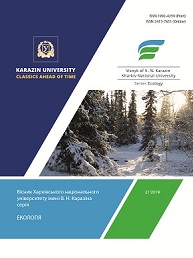Environmentally Safe Method of Localization of Soil Pollution in Emergency Situations of Technogenic Nature
Abstract
Puporse. Development a method for the localization of emergencies associated with the leakage of volatile toxic liquids, by using the foams with adjustable curing time. Methods. Surface insulation method of the spilled toxic liquid by using the air-mechanical foam. Results. The results of the development a method for the localization of emergencies associated with the leakage of volatile toxic liquids, by using the foams with adjustable curing time are presented. The new scientific result consists in the use of gelation processes, to obtain an insulating agent with a specified time of curing. It has been established that the most effective means that reduce the rate of transition of toxic liquids to the gas phase are those that ensure the liquid surface isolation. It is proposed to use foam with the time of cure that can be adjust ed. Experimentally determined gel times for two gel forming systems (NH4Cl + Na2O • 2,5SiO2 and (NH4)2SO4+ Na2O ∙ 2,5SiO2). On the basis of the data obtained, the concentrations of the gel formulation and the gelation catalyst with the gel time were selected in the interval of 30-60 s. Conclusions. The developed systems allow to achieve a long process of isolation at a lower specific consumption of components. It is shown that the use of the proposed components in the soil is an environmentally safe process.Downloads
References
Nazarov, O. A., Kuleshov, N. N. (Eds.) (2006). Fire fighting and rescue operations: a guide. Kharkov: ATSZU. (In Russian).
Grek, A. M., Sakun, O. V., Grigorov, O. M. (2006). Accidents at radiation, chemically and biologically hazardous objects: a reference book. Kharkov: FVP NTU "KhPI". (In Russian).
Slepuzhnikov, E. D., Tarakhno, O. V., Ponomarenko, R. V., Buts, Y. V. (2018). Improving the control of sampling of liquid, gaseous and bulk substances in the study of man-made environmental impact. Man and the environment. Issues of neoecology. (30), 148–157. (In Ukranian).
Bariev, E. R. (2008). Emergencies with chemically hazardous substances. Minsk: IVC Minfina. (In Russian).
Zasady organizacji decontominacji w warunkach scazenia srodkami CBRN w pzypadku zdarzen masowych podczas Swiatowych Dni Mlodziezy (2016). PSPRP Polska. Warszawa. 20.
Kireev, A. A. (2017). An experimental study of the influence of the characteristics of a gel-like layer on its insulat-ing properties with respect to vapors of organic liquids. Problems of suprasubic situations, (26), 43‒48. (In Russian).
Abramov, Yu. A., Kireev, A. A. (2015). Gelling extinguishing and fire-retardant means of increased efficiency in relation to class A fires. Kharkov: NUGZU. (In Russian).
Dadashov, I. F., Kireev, A. A. (2016). Increasing the efficiency of extinguishing combustible liquids in tanks by using gelling agents. Proceedings of Azerbaijan statemarine academy, (2), 72‒76. (In Russian).
Foamed silica gel, the use of foamed silica gel as a fire extinguishing agent and sol-gel method for its preparation. (2015). US Pat. 2590379 Russian Federation. No. 20151010625/05. (In Russian).
Kireev, A. A., Kolenov, A. N. (2008). Ways to increase the efficiency of foam fire fighting. Fire safety issues, (24), 50‒53. (In Russian).
Kireev, A. A., Kolenov, A. N. (2009). The study of foaming in foaming systems. Fire safety issues, (25), 59‒64. (In Russian).
Mewis, J. (2009). Thixotropy. Advances in Colloid and Interface Science. V. 147–148, March–June, 214‒227.
Galla, S., Stefanicky, B., Majlingova A. (2017). Experimental comparison of the fire extinguishing properties of the firesorb® gel and water, 17th International Multidisciplinary Scientific Geo Conference, 439‒446.
Mоlochkina, D. I. Liquid self-hardening mixture. Pat.837551 SSSR №837551. (In Russian).
Authors who publish with this journal agree to the following terms:
- Authors retain copyright and grant the journal right of first publication of this work under the terms of a license Creative Commons Attribution License 4.0 International (CC BY 4.0).
- Authors are able to enter into separate, additional contractual arrangements for the non-exclusive distribution of the journal's published version of the work (e.g., post it to an institutional repository or publish it in a book), with an acknowledgement of its initial publication in this journal.
- Authors are permitted and encouraged to post their work online (e.g., in institutional repositories or on their website) prior to and during the submission process, as it can lead to productive exchanges, as well as earlier and greater citation of published work.





